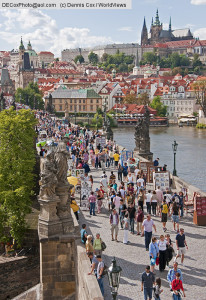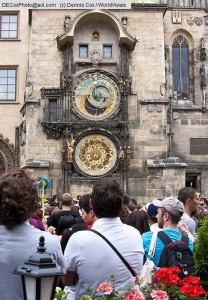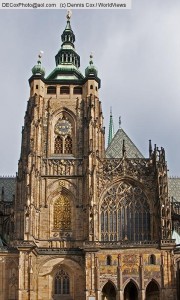Somehow the Czech Republic had eluded me in my travels until two weeks ago, when I was invited as a guest on an Insight Vacations tour that spent two days in Prague and one day in Cesky Krumlov, a medieval town in the southern part of the country.
If you’ve been following my previous posts, you’ll know that we toured the main attractions as well as some of the more historic beer halls and restaurants in Prague, and spent a day with overnight in Cesky Krumlov, a well-preserved “fairytale town” that “went to sleep,” as our excellent guide put it, for 300 years following Europe’s destructive Thirty Years War in the early 17th century.
Here are ten things I didn’t know about the Czech Republic before I arrived (with thanks to our Insight Vacations tour director, Neira Milkovic, as well as our knowledgeable local guides, for several of these insights). Some are versions from earlier posts, in case you missed them:
* The Czech Republic is home to more than 2,000 castles, keeps and castle ruins, one of the highest castle densities in the world. The two largest are Prague Castle, now the site of the Czech president’s offices and the largest still-occupied castle in the world, and the castle at Cesky Krumlov, which was used as a hunting lodge by some of Europe’s wealthiest families.
* The Czechs drink more beer per capita than any other nation on earth: 40 gallons for every man, woman and child in the country. The very word “pilsner” comes from the town of Pilsen in the Czech Republic.
* The Budweiser beer sold in the Czech Republic is the original Budweiser and unrelated to that brewed by Anheuser Busch in the United States. In fact, the two breweries have been fighting a still-heated century-long legal battle over rights to the name; various rulings allow the Czech Budweiser to market it under that name in most of Europe, while the American brand must be sold as “Bud” there. (The Czech version is sold as “Czechvar” in the U.S.)
The name “Budweiser” is derived from the Czech town of Budweis (now known as Ceske Budejovice), which has been brewing beer since the 13th century. Known as the “Beer Of Kings” when Adolphus Busch visited the Bohemian (Czech) brewery in 1870, the Budweiser name was then adopted by Busch for the U.S. market — as was his twist on the slogan, which became the “King of Beers.” The Czech original is excellent, full-bodied beer, so don’t be afraid to order it. You may also see the beer sold under name Budejovicky Budvar.
* Besides beer, the Czech Republic is perhaps best known for producing crystal and ham. A favorite dish is dumplings, served alongside huge portions of pork or beef.
* Defenestration — the act of tossing an opponent out a window — has played a big role in Czech history. A defenestration incident at Prague castle is blamed for helping to set off Europe’s Thirty Years War, and, in the more modern era, Jan Masaryk, the only non-Communist member of the Parliament following the Soviet occupation of Czechoslovakia after World War II , fell to his death from a third-story window in 1948. While the Soviets claimed it was suicide, our guide told us that “In all likelihood, he was ‘suicided.'” In short, a likely victim of defenestration.
* “Good King Wenceslas” of Christmas carol fame was actually a duke who was murdered by his brother and buried in the cathedral located within Prague Castle. The noblemen buried there apparently didn’t have properly sealed tombs, leaving their bodies to decompose rather publicly and giving rise to the term “stinking rich.”
* Both Prague and Cesky Krumlov have prominently placed museums devoted to the instruments of medieval torture.
* Some 40,000 U.S. expats live in Prague, a 21st century version of what Paris was to young people in the 1960s and early 1970s.
* The Nazis preserved Prague’s old Jewish Quarter to serve as a “museum of an extinct race,” and brought Jewish artifacts they had looted from around Europe to display as exhibits.
* The Czech Republic may harbor the world’s oldest town. According to the Guinness Book of World Records, the archaeological site of Dolni Vestonice near the current village of the same name in Southern Moravia dates back to around 27,000 BC.
Bonus:
* While Prague does have McDonald’s and KFC franchises, among others, Dunkin’ Donuts and Pizza Hut tried and failed to catch on here.















2 Responses to Ten Things I Didn’t Know About the Czech Republic